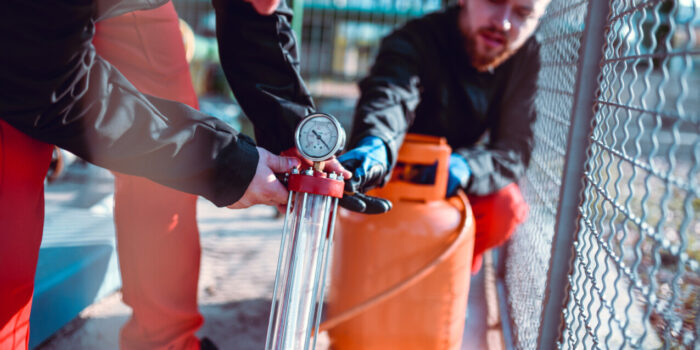These are the so-called pourers (or NOs), which are subject to the Transport Technical Supervision (TDT). The TDT is a state legal entity operating on the basis of the Act of 21 December 2000 on technical supervision. It is a technical supervision unit and is subject to the minister in charge of transport. Its supervision applies to technical equipment that has been installed, e.g. on railway premises, railway rail vehicles, railway sidings and tanks (including tanks that are used in road, railway and inland waterway traffic).
Facilities for repairing and emptying tanks are:

- instruments for emptying and filling transport tanks (including: loading arms for liquid, gaseous and solid hazardous materials);
- port loading arms (installations and systems for filling inland waterway and maritime vessels with gases or liquid materials);
- flexible dock lines;
- instruments for emptying and filling at a pressure higher than 0.5 bar.
Among other things, tanks containing hazardous materials (toxic, flammable corrosive) are emptied and filled. Such a NO machine must safely fill and empty a tanker into the tanks stored in the liquid storage area. In this case, UNO stations have a number of electronic and mechanical solutions that maintain a high level of safety (for both installations and employees).
Hazardous materials
The hazardous materials mentioned are cargoes or objects containing such materials which may be a danger to human health and life and to the environment. These include any explosive objects, gases, organic peroxides, radioactive materials, etc. We can classify these goods on the basis of their biological, physical, chemical properties, as well as the hazard they pose. We distinguish between the following classes of them:
- Class 1: explosive materials and objects. These include hazards such as fragmentation, fire and mass explosion. These include firecrackers, flares, fireworks and grenades.
- Class 2: all gases. There are hazards of poisoning, fire, explosion, pressurised gas emissions. These include liquefied gases, dissolved gases, compressed gases or aerosol containers.
- Class 3: Flammable liquids. There is a risk of explosion or fire. These include solvents, alcoholic beverages, paints, tars, adhesives or wood preservatives.
- Class 4: they are self-reactive, solid and solid desensitised and polymerised materials. They are usually in the form of powder, paste or granules. They can ignite due to friction during transport. Therefore, some of them require controlled temperature during transport.
- Class 5: these are organic peroxides (give off large amounts of heat during decomposition. Their spontaneous combustion may occur with strong oxidising properties) and oxidising materials (strong reaction in contact with combustible materials).
- Grade 6: these are all infectious materials (e.g. diagnostic specimens, post-operative or medical waste), contact with which may result in life-threatening human disease, and poisonous materials (plant protection products, germicides or de-fungicides), which may cause death by poisoning.
- Grade 7: All radioactive materials belong to this class. These include, for example, isotopic smoke detectors, nuclear fuels, which pose a radiation hazard. If we do not have specialised equipment, it is undetectable and invisible.
- Grade 8: these are all corrosive materials. Contact with them may cause chemical burns. This includes bleach, acids and alkalis.
- Grade 9: miscellaneous objects and hazardous materials. This class includes here materials whose hazard is different from that of classes 1 to 8.
Dangerous goods classified in this way, when properly packed and labelled, can be transported. Dangerous goods, in order to be labelled correctly, should have a product identification number (UN) and the vehicle carrying such goods should have a reflective orange information board. Vehicles that transport dangerous goods in tanks or in bulk must also have hazard identification number plates. And drivers, together with employees who are involved in the unloading and loading of dangerous goods, are required to have the appropriate ADR certificates.
What is ADR?
ADR is a name taken from the English language, which stands for The European Agreement Concerning the International Carriage of Dangerous Goods by Road. The ADR is therefore a European agreement (signed by more than 50 countries) that concerns the carriage of dangerous goods. It is a requirement that a driver transporting dangerous substances is required to hold an ADR certificate.
ADR, TDT training

The purpose of such an ADR course is to familiarise the driver with the hazards that may occur during the transport of dangerous goods, how to minimise an accident, and, when an accident occurs, what the driver has to do to reduce its negative effects. The ADR course addresses issues such as: the classification of hazardous materials, the transport of explosives, radioactive materials, etc., the types of hazards, what to do in the event of an accident, the types of documentation required or civil liability.
Those who operate filling machines (which are subject to the Transport Technical Supervision) must also undergo a training course, which ends with a state exam. During the course, participants learn about hazardous materials and their chemical properties, how to operate UNO-type machines, the necessary health and safety and fire protection regulations, as well as about markings and descriptions on transport tanks. After passing the exam, the participant receives a certificate valid indefinitely.
A few words about pouring machines
Equipment for filling and emptying tanks is called pouring machines. In order to use them, as written earlier, you need the appropriate qualifications. These machines are used in road, rail, sea and inland waterway traffic. They consist of tubular sections, connected by rotary valves, limited by a valve and a connecting section to the tank to be emptied or filled.


